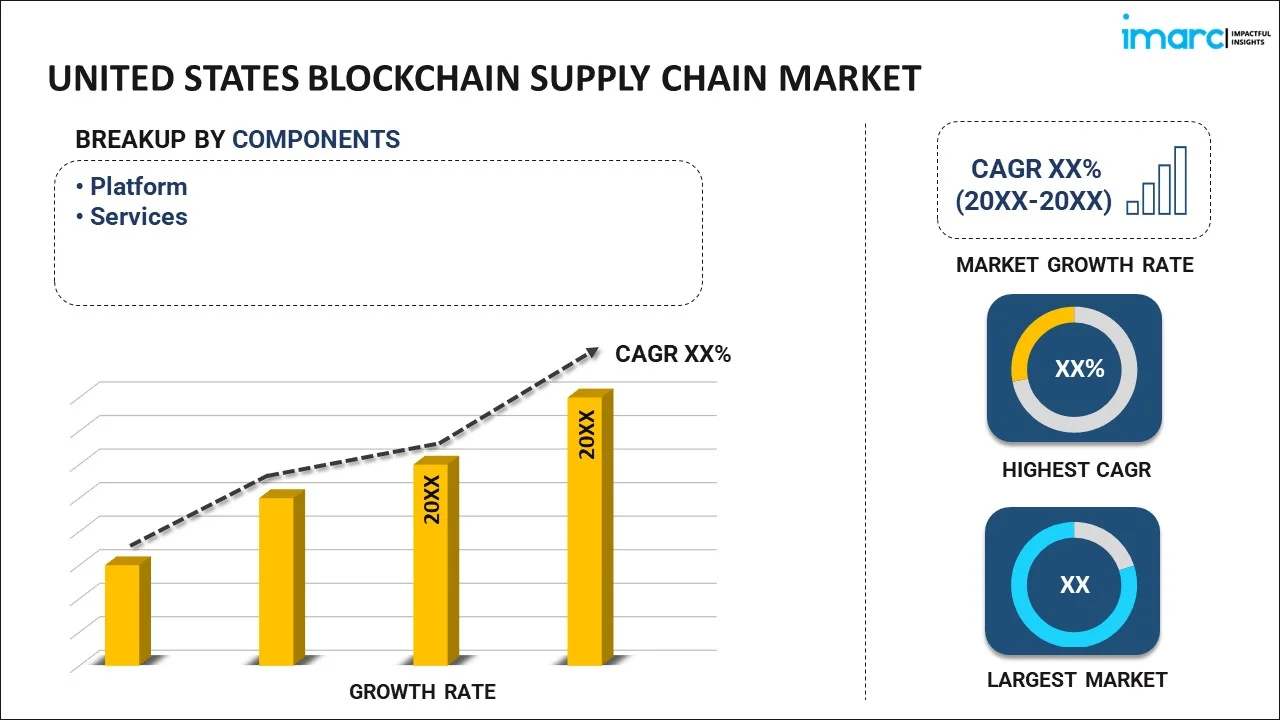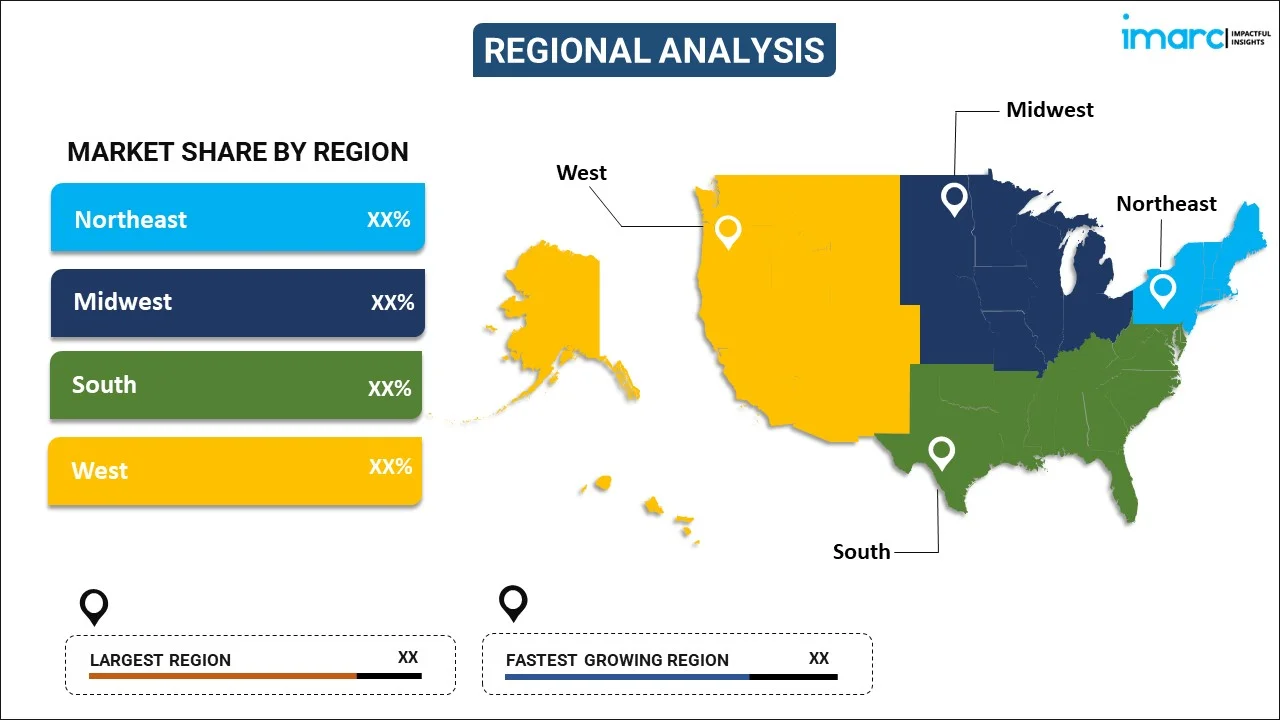
United States Blockchain Supply Chain Market Report by Component (Platform, Services), Application (Smart Contracts, Payment and Settlement, Product Traceability, Inventory Monitoring, Compliance Management, and Others), Industry Vertical (Retail, Manufacturing, Food and Beverages, Healthcare, Oil and Gas, and Others), and Region 2025-2033
Market Overview:
United States blockchain supply chain market size reached USD 289.16 Million in 2024. Looking forward, IMARC Group expects the market to reach USD 8,949.83 Million by 2033, exhibiting a growth rate (CAGR) of 46.43% during 2025-2033. The integration of blockchain and IoT devices, which allows for real-time tracking of goods in the supply chain to enhance visibility, is driving the United States blockchain supply chain market share.
|
Report Attribute
|
Key Statistics
|
|---|---|
|
Base Year
|
2024
|
|
Forecast Years
|
2025-2033
|
|
Historical Years
|
2019-2024
|
|
Market Size in 2024
|
USD 289.16 Million |
|
Market Forecast in 2033
|
USD 8,949.83 Million |
| Market Growth Rate 2025-2033 | 46.43% |
United States Blockchain Supply Chain Market Analysis:
- Major Drivers: Demand for transparency, traceability, and real-time visibility drives blockchain adoption in U.S. supply chains. Increased regulatory compliance, anti-counterfeiting efforts, and consumer demands for ethical sourcing spur blockchain integration. Businesses pursue cost savings, fraud prevention, and process efficiency, driving investments in logistics, retail, healthcare, and manufacturing industries.
- Key Market Trends: A few of the Key United States blockchain supply chain market trends include blockchain integration with Internet of Things (IoT), Artificial Intelligence (AI), and cloud platforms for end-to-end visibility. Blockchain networks led by consortia are growing amongst retail and logistics players. Increasing emphasis on sustainability reporting and ESG compliance increases the use of blockchain. Tokenization of assets, smart contracts, and decentralized finance applications are revolutionizing supply chain transactions.
- Market Opportunities: Opportunity exists in improving efficiency, lowering conflicts, and building trust along fragmented supply chains. Blockchain generates new value in food safety, pharma traceability, and high-value goods authentication. SMEs embracing blockchain-as-a-service gain lower entry points. Federal interest in digital infrastructure and enterprise collaboration further opens growth opportunities for innovators.
- Market Challenges: According to the United States blockchain supply chain market analysis, among the key challenges are excessive costs of implementation, absence of interoperability standards, and complexity of integration with existing systems. Scalability problems, regulatory ambiguity, and unwillingness to provide sensitive data hamper acceptance. Gaps in blockchain skills continue. Maintaining cybersecurity, governance, and alignment of stakeholders continues to prove difficult and slows broad-based deployment despite identified value potential.
Blockchain in the supply chain is a decentralized and secure system that utilizes a distributed ledger to track and authenticate the flow of goods and information across the supply network. Each transaction or event is recorded in a block linked to the previous one, forming an unalterable chain. This technology enhances transparency, traceability, and accountability, reducing fraud and errors. Smart contracts embedded in the blockchain automate and enforce agreements, streamlining processes such as payments and compliance. Participants in the supply chain, including manufacturers, suppliers, distributors, and retailers, can access real-time, immutable data, fostering trust and collaboration. Ultimately, blockchain in the supply chain promotes efficiency, reduces costs, and mitigates risks by creating a tamper-resistant record of the entire product journey from production to delivery.
United States Blockchain Supply Chain Market Trends:
Demand for Transparency and Traceability
One of the most compelling reasons for blockchain adoption in U.S. supply chains is rising demand for transparency and visibility. Consumers, regulators, and business partners increasingly require precise, real-time data on the origin, movement, and status of goods. Blockchain facilitates immutable records and end-to-end visibility, essential in sectors such as food, pharmaceuticals, and high-end goods. For instance, rapid tracing of tainted food products avoids health crises and reduces recalls. Likewise, in pharmaceuticals, blockchain prevents counterfeiting of drugs, safeguards patients, and also enables compliance with FDA regulations like the Drug Supply Chain Security Act (DSCSA). By establishing trust and accountability among all stakeholders, blockchain not only builds brand reputation but also enhances operational effectiveness. This need for traceability is likely to continue rising as sustainability and Environmental, Social, and Governance (ESG) needs become stricter in U.S. markets.
Regulatory Compliance and Anti-Counterfeiting Needs
Pressure to regulate and fight counterfeiting is a leading driver of blockchain implementation in U.S. supply chains. Sectors such as pharmaceuticals, aviation, and defense are subject to rigorous federal regulations to guarantee product authenticity and conformity. The U.S. Drug Supply Chain Security Act (DSCSA) is a good example, mandating serialization and trackability of drugs throughout the distribution channel by 2023–2025. Blockchain provides an untamperable and verifiable record that better meets these demands compared to conventional systems. Aside from regulatory compliance, the American economy loses billions of dollars because of counterfeits in industries like luxury fashion, electronics, and automotive components. Blockchain makes it possible to verify product legitimacy and mitigate the risk of fraud. Through the provision of tamper-proof documents, businesses can protect intellectual property, ensure customer confidence, and enhance supply chain resilience against counterfeit incursion, thereby making compliance a strategic benefit.
Efficiency Gains and Cost Reduction
The need for cost savings and efficiency in U.S. supply chains is another significant factor supporting the United States blockchain supply chain market growth. Conventional supply chain structures are susceptible to fragmented silos of data, manual paperwork, and cumbersome reconciliation processes, leading to delays and costs. Blockchain simplifies these through the automation of verification with smart contracts and secure real-time sharing of data between parties. For instance, logistics businesses can minimize paperwork, reduce administrative overhead, and eliminate expensive disputes through the use of blockchain-based transactional records. Retailers and producers can gain the advantages of accelerated settlement cycles, enhanced inventory management, as well as decreased operational risks. In global trade, blockchain minimizes inefficiencies due to customs clearance delays and fake paperwork. Through reduced transaction costs and better coordination, blockchain increases competitiveness and profitability, offering a powerful solution to U.S. businesses looking to maximize increasingly complicated global supply networks.
United States Blockchain Supply Chain Market Segmentation:
IMARC Group provides an analysis of the key trends in each segment of the market, along with forecasts at the country level for 2025-2033. Our report has categorized the market based on component, application, and industry vertical.
Component Insights:

To get more information on this market, Request Sample
- Platform
- Services
The report has provided a detailed breakup and analysis of the market based on the component. This includes platform and services.
Application Insights:
- Smart Contracts
- Payment and Settlement
- Product Traceability
- Inventory Monitoring
- Compliance Management
- Others
A detailed breakup and analysis of the market based on the application have also been provided in the report. This includes smart contracts, payment and settlement, product traceability, inventory monitoring, compliance management, and others.
Industry Vertical Insights:
- Retail
- Manufacturing
- Food and Beverages
- Healthcare
- Oil and Gas
- Others
The report has provided a detailed breakup and analysis of the market based on the industry vertical. This includes retail, manufacturing, food and beverages, healthcare, oil and gas, and others.
Regional Insights:

- Northeast
- Midwest
- South
- West
The report has also provided a comprehensive analysis of all the major regional markets, which include the Northeast, Midwest, South, and West.
Competitive Landscape:
The market research report has also provided a comprehensive analysis of the competitive landscape in the market. Competitive analysis such as market structure, key player positioning, top winning strategies, competitive dashboard, and company evaluation quadrant has been covered in the report. Also, detailed profiles of all major companies have been provided.
United States Blockchain Supply Chain Market Report Coverage:
| Report Features | Details |
|---|---|
| Base Year of the Analysis | 2024 |
| Historical Period | 2019-2024 |
| Forecast Period | 2025-2033 |
| Units | Million USD |
| Scope of the Report | Exploration of Historical and Forecast Trends, Industry Catalysts and Challenges, Segment-Wise Historical and Predictive Market Assessment:
|
| Components Covered | Platform, Services |
| Applications Covered | Smart Contracts, Payment and Settlement, Product Traceability, Inventory Monitoring, Compliance Management, Others |
| Industry Verticals Covered | Retail, Manufacturing, Food and Beverages, Healthcare, Oil and Gas, Others |
| Regions Covered | Northeast, Midwest, South, West |
| Customization Scope | 10% Free Customization |
| Post-Sale Analyst Support | 10-12 Weeks |
| Delivery Format | PDF and Excel through Email (We can also provide the editable version of the report in PPT/Word format on special request) |
Key Benefits for Stakeholders:
- IMARC’s industry report offers a comprehensive quantitative analysis of various market segments, historical and current market trends, market forecasts, and dynamics of the United States blockchain supply chain market from 2019-2033.
- The research report provides the latest information on the market drivers, challenges, and opportunities in the United States blockchain supply chain market.
- Porter's five forces analysis assist stakeholders in assessing the impact of new entrants, competitive rivalry, supplier power, buyer power, and the threat of substitution. It helps stakeholders to analyze the level of competition within the United States blockchain supply chain industry and its attractiveness.
- Competitive landscape allows stakeholders to understand their competitive environment and provides an insight into the current positions of key players in the market.
Key Questions Answered in This Report
The blockchain supply chain market in the United States was valued at USD 289.16 Million in 2024.
The United States blockchain supply chain market is projected to exhibit a CAGR of 46.43% during 2025-2033, reaching a value of USD 8,949.83 Million by 2033.
The United States blockchain supply chain market is driven by rising demand for transparency, growing need to combat counterfeiting, and improved traceability of goods. Increasing adoption across industries, regulatory support for secure transactions, and integration with IoT and AI technologies further enhance efficiency, trust, and operational resilience in supply chains.
Need more help?
- Speak to our experienced analysts for insights on the current market scenarios.
- Include additional segments and countries to customize the report as per your requirement.
- Gain an unparalleled competitive advantage in your domain by understanding how to utilize the report and positively impacting your operations and revenue.
- For further assistance, please connect with our analysts.
 Request Customization
Request Customization
 Speak to an Analyst
Speak to an Analyst
 Request Brochure
Request Brochure
 Inquire Before Buying
Inquire Before Buying




.webp)




.webp)












